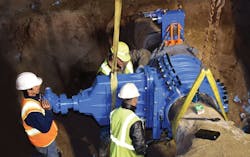Indiana Installation
Mishawaka, Ind.’s water department needed a valve installed on an existing 20-in. trunk line, but some conditions complicated the project. The trunk line had multiple broken valves that would not allow the water department to limit the scope of a service shutdown to the large community of users. The department very much wanted to avoid stopping service to the complete line. This dictated the use of an insertion valve system that could be installed while maintaining full pressure.
Another challenge involved the planned location of the new valve. The chosen site was at a particularly shallow depth and a standard, 20-in. resilient wedge gate valve would leave the top of the valve bonnet and the actuator nut exposed above ground. This was not possible at the chosen site.
The water department reviewed its options and searched for a valve that delivered the right size, the ability to install under pressure and the adaptability to provide a way to stay below ground level at the desired location.
Finding a Solution
Valve Selection
The department chose the EZ Valve from Advanced Valve Technologies (AVT) because it provided all the features needed and also could be affordably customized to meet the low vertical profile required. It is the only 20-in. insertion valve available in North America. Each valve is factory pressure tested before delivery and includes UL listing, AWWA material specs and is certified to NSF/ANSI 61.
Special Modification
AVT adapted a standard valve for horizontal application by designing, machining and welding a custom support track inside the valve bonnet. This track supports the resilient wedge gate as it rides on its side inside the bonnet and enables smooth operation of the gate even at 90 degrees off of normal position. Another modification also was prepared: A right-angle gearbox was attached to the valve nut so that actuation remains as usual from the ground level and still by the same number of turns.
Preparation
In comparison to other systems, site prep was greatly reduced. Due to the compact fittings and the minimally invasive design of the EZ Valve system, only a single and smaller excavation is required. A built-in isolation gate allows the valve to be installed under pressure without additional supplemental equipment. The system also uses a slot-access design that only opens the pipeline with a narrow milled slot normally cut over the top 120 degrees of the single pipe length involved. In this horizontal application the slot was milled on the side, centered 90 degrees off the vertical. Maintaining the pipe’s structural integrity avoids costly restraint procedures such as framing, concrete work and extended man-hours.
Valve Installation
The installation proceeded in three phases. First, the pipe section was cleaned, lubricated and fitted with the valve body castings. A gasket system has the flexibility to adapt to imprecise outside diameters and even irregular geometries while allowing the assembled body to rotate on the pipe length and still maintain line pressure.
Phase two addressed valve access to the pipe length while under full pressure. A universal milling machine with multi-use and easily replaceable cutters was temporarily attached to the bonnet plate and the body was then rotated to cut an access slot for the resilient wedge gate. This milling process makes a 3½-in. slot over a 120-degree path while capturing the milled debris. The slot for a normal vertical bonnet installation is centered on the top of the pipe diameter. In this case the milling process was precision adjusted to center the slot on the horizontal plane.
The final phase covered the attachment of the valve bonnet to the body and operation of the valve to confirm closure. Once the valve operation was cycled and tested, the body bolts were fully tightened and the locking bolts secured the valve body in final position.
The complete process is minimally invasive and never severs the pipe length or drops a coupon. The pipeline integrity is maintained throughout the installation. Simple blocks were placed to support the horizontal bonnet and the excavation was filled.
Favorable Results
The new 20-in. EZ Valve is in place and working properly. It was installed under pressure with no service interruption and in the desired location. The valve operates normally and did not require restraint measures. The surface above the new valve is restored and not obstructed.
Customization of the valve for horizontal use was not cost-prohibitive. Water treatments such as chlorination, dechlorination, boil orders and so on were not needed. Maintaining service meant there was no loss of fire protection. Public notification of shutdown activities was avoided.
The valve provides a drip-tight seal that performs even in heavily tuberculated pipe. Conservation of water, minimal earth removal and replacement and reduced energy consumption meant the project had a low environmental impact. Finally, the total installed cost was preferable to those of larger multiple excavation options requiring extensive tool kits, more heavy equipment usage and remedial restraint operations.
Kevin Murphy is president of Advanced Valve Technologies Inc. Majewski is manager of the Mishawaka Indiana Water Division. Murphy and Majewski can be reached at [email protected].
